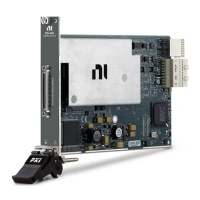5-8 | ni.com
Chapter 5 Analog Output
Using a Digital Source
To use AO Pause Trigger, specify a source and a polarity. The source can be one of the following
signals:
• PFI <0..15>
• RTSI <0..7>
• PXI_STAR
• PXIe_DSTAR<A,B>
• Counter n Internal Output
• Counter n Gate
• AI Pause Trigger (ai/PauseTrigger)
• DI Pause Trigger (di/PauseTrigger)
• DO Pause Trigger (do/PauseTrigger)
The source can also be one of several other internal signals on your DAQ device. Refer to Device
Routing in MAX in the NI-DAQmx Help or the LabVIEW Help for more information.
You can also specify whether the samples are paused when AO Pause Trigger is at a logic high
or low level.
Using an Analog Source
When you use an analog trigger source, the samples are paused when the Analog Comparison
Event signal is at a high level. Refer to the
Triggering with an Analog Source section of
Chapter 11,
Triggering, for more information.
Routing AO Pause Trigger Signal to an Output Terminal
You can route AO Pause Trigger out to any PFI <0..15>, RTSI <0..7>, or PXIe_DSTARC
terminal.
AO Sample Clock Signal
Use the AO Sample Clock (ao/SampleClock) signal to initiate AO samples. Each sample
updates the outputs of all of the DACs. You can specify an internal or external source for AO
Sample Clock. You can also specify whether the DAC update begins on the rising edge or falling
edge of AO Sample Clock.
Using an Internal Source
One of the following internal signals can drive AO Sample Clock:
• AO Sample Clock Timebase (divided down)
• Counter n Internal Output
• Change Detection Event
• Counter n Sample Clock

